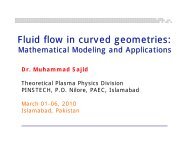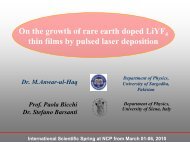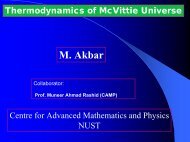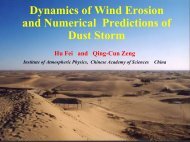Non-linear electrostatic waves in pair-ion plasmas - National Centre ...
Non-linear electrostatic waves in pair-ion plasmas - National Centre ...
Non-linear electrostatic waves in pair-ion plasmas - National Centre ...
You also want an ePaper? Increase the reach of your titles
YUMPU automatically turns print PDFs into web optimized ePapers that Google loves.
7. Conclus<strong>ion</strong>• L<strong>in</strong>ear and non<strong>l<strong>in</strong>ear</strong> <strong>electrostatic</strong> <strong>waves</strong> are studied <strong>in</strong>unmagnetized <strong>pair</strong>-<strong>ion</strong> <strong>plasmas</strong>.• Korteweg-de Vries (KdV) equat<strong>ion</strong> is obta<strong>in</strong>ed us<strong>in</strong>g reductiveperturbat<strong>ion</strong> method.• Both <strong>electrostatic</strong> potential hump and dip solitons are obta<strong>in</strong>ed<strong>in</strong> unmagnetized <strong>pair</strong>-<strong>ion</strong> <strong>plasmas</strong>.• The <strong>electrostatic</strong> potential humps are formed, when thetemperature of negative <strong>ion</strong> species <strong>in</strong> greater than the positive<strong>ion</strong>s, while <strong>in</strong> reverse temperature condit<strong>ion</strong>s potential dips areobta<strong>in</strong>ed.• Both compressive and rarefactive potential double layers areobta<strong>in</strong>ed depend<strong>in</strong>g on the ratio between difference <strong>in</strong> positiveand negative <strong>ion</strong> species.33
















